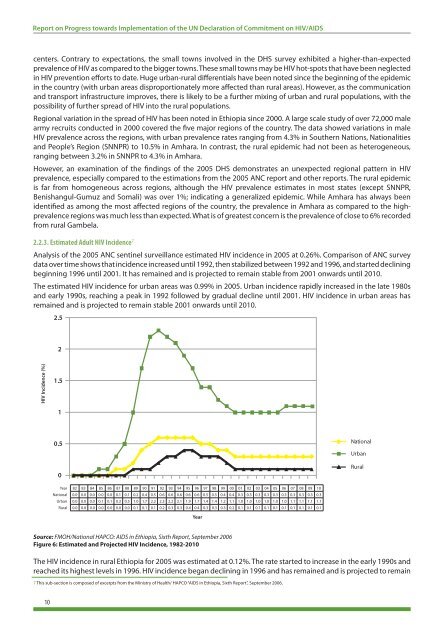Ethiopia - Country Progress Report - unaids
Ethiopia - Country Progress Report - unaids
Ethiopia - Country Progress Report - unaids
You also want an ePaper? Increase the reach of your titles
YUMPU automatically turns print PDFs into web optimized ePapers that Google loves.
<strong>Report</strong> on <strong>Progress</strong> towards Implementation of the UN Declaration of Commitment on HIV/AIDS<br />
centers. Contrary to expectations, the small towns involved in the DHS survey exhibited a higher-than-expected<br />
prevalence of HIV as compared to the bigger towns. These small towns may be HIV hot-spots that have been neglected<br />
in HIV prevention efforts to date. Huge urban-rural differentials have been noted since the beginning of the epidemic<br />
in the country (with urban areas disproportionately more affected than rural areas). However, as the communication<br />
and transport infrastructure improves, there is likely to be a further mixing of urban and rural populations, with the<br />
possibility of further spread of HIV into the rural populations.<br />
Regional variation in the spread of HIV has been noted in <strong>Ethiopia</strong> since 2000. A large scale study of over 72,000 male<br />
army recruits conducted in 2000 covered the five major regions of the country. The data showed variations in male<br />
HIV prevalence across the regions, with urban prevalence rates ranging from 4.3% in Southern Nations, Nationalities<br />
and People’s Region (SNNPR) to 10.5% in Amhara. In contrast, the rural epidemic had not been as heterogeneous,<br />
ranging between 3.2% in SNNPR to 4.3% in Amhara.<br />
However, an examination of the findings of the 2005 DHS demonstrates an unexpected regional pattern in HIV<br />
prevalence, especially compared to the estimations from the 2005 ANC report and other reports. The rural epidemic<br />
is far from homogeneous across regions, although the HIV prevalence estimates in most states (except SNNPR,<br />
Benishangul-Gumuz and Somali) was over 1%; indicating a generalized epidemic. While Amhara has always been<br />
identified as among the most affected regions of the country, the prevalence in Amhara as compared to the highprevalence<br />
regions was much less than expected. What is of greatest concern is the prevalence of close to 6% recorded<br />
from rural Gambela.<br />
2.2.3. Estimated Adult HIV Incidence 7<br />
Analysis of the 2005 ANC sentinel surveillance estimated HIV incidence in 2005 at 0.26%. Comparison of ANC survey<br />
data over time shows that incidence increased until 1992, then stabilized between 1992 and 1996, and started declining<br />
beginning 1996 until 2001. It has remained and is projected to remain stable from 2001 onwards until 2010.<br />
The estimated HIV incidence for urban areas was 0.99% in 2005. Urban incidence rapidly increased in the late 1980s<br />
and early 1990s, reaching a peak in 1992 followed by gradual decline until 2001. HIV incidence in urban areas has<br />
remained and is projected to remain stable 2001 onwards until 2010.<br />
2.5<br />
2<br />
HIV Incidence (%)<br />
1.5<br />
1<br />
0.5<br />
0<br />
National<br />
Urban<br />
Rural<br />
Year 82 83 84 85 86 87 88 89 90 91 92 93 94 95 96 97 98 99 00 01 02 03 04 05 06 07 08 09 10<br />
National 0.0 0.0 0.0 0.0 0.0 0.1 0.1 0.2 0.4 0.5 0.6 0.6 0.6 0.6 0.6 0.5 0.5 0.4 0.4 0.3 0.3 0.3 0.3 0.3 0.3 0.3 0.3 0.3 0.3<br />
Urban 0.0 0.0 0.0 0.1 0.1 0.3 0.5 1.0 1.7 2.2 2.3 2.2 2.1 1.9 1.7 1.4 1.4 1.2 1.1 1.0 1.0 1.0 1.0 1.0 1.0 1.1 1.1 1.1 1.1<br />
Rural 0.0 0.0 0.0 0.0 0.0 0.0 0.0 0.1 0.1 0.1 0.2 0.3 0.3 0.4 0.4 0.3 0.3 0.3 0.2 0.1 0.1 0.1 0.1 0.1 0.1 0.1 0.1 0.1 0.1<br />
Year<br />
Source: FMOH/National HAPCO: AIDS in <strong>Ethiopia</strong>, Sixth <strong>Report</strong>, September 2006<br />
Figure 6: Estimated and Projected HIV Incidence, 1982-2010<br />
The HIV incidence in rural <strong>Ethiopia</strong> for 2005 was estimated at 0.12%. The rate started to increase in the early 1990s and<br />
reached its highest levels in 1996. HIV incidence began declining in 1996 and has remained and is projected to remain<br />
7 This sub-section is composed of excerpts from the Ministry of Health/ HAPCO “AIDS in <strong>Ethiopia</strong>, Sixth <strong>Report</strong>”, September 2006.<br />
10

















